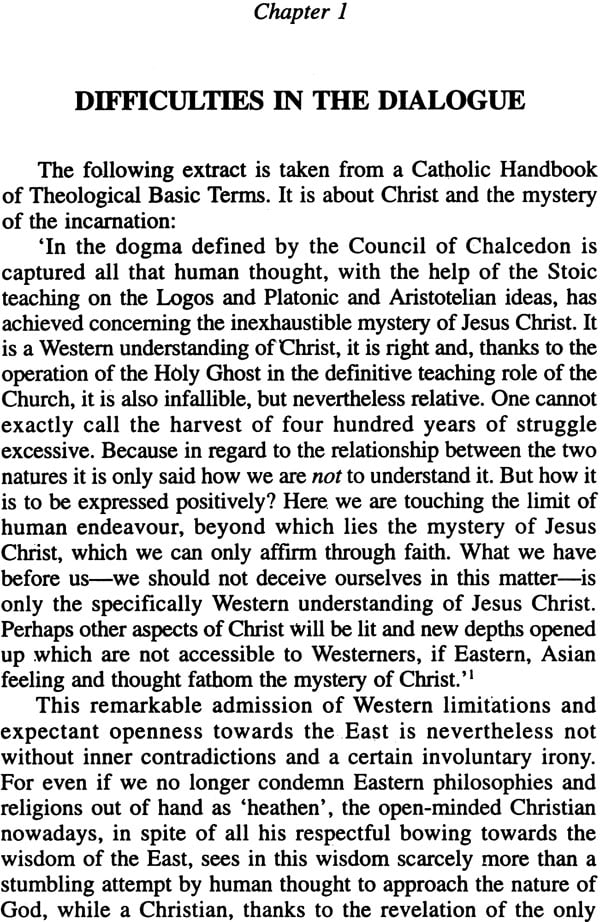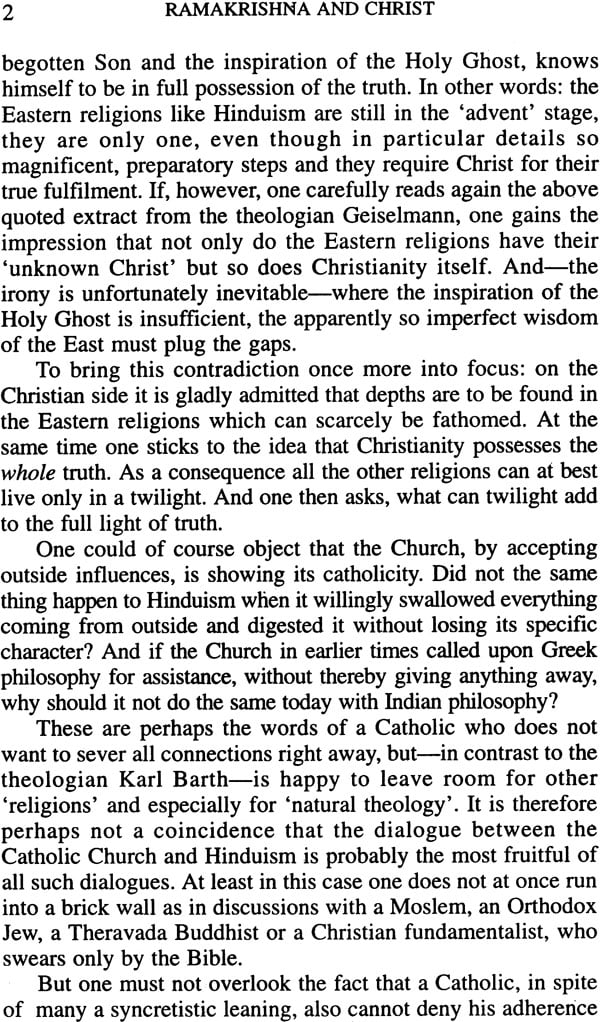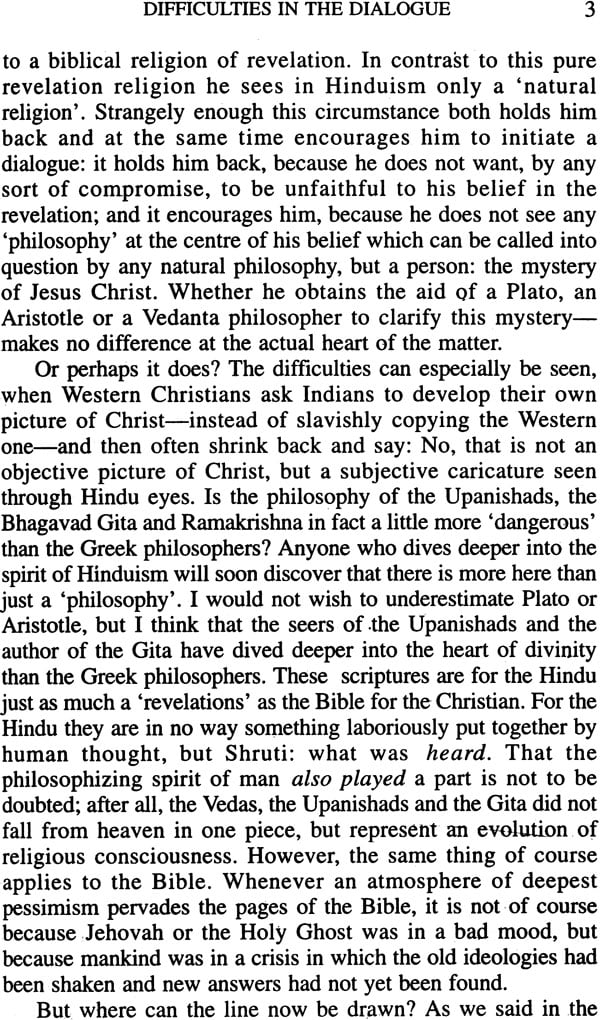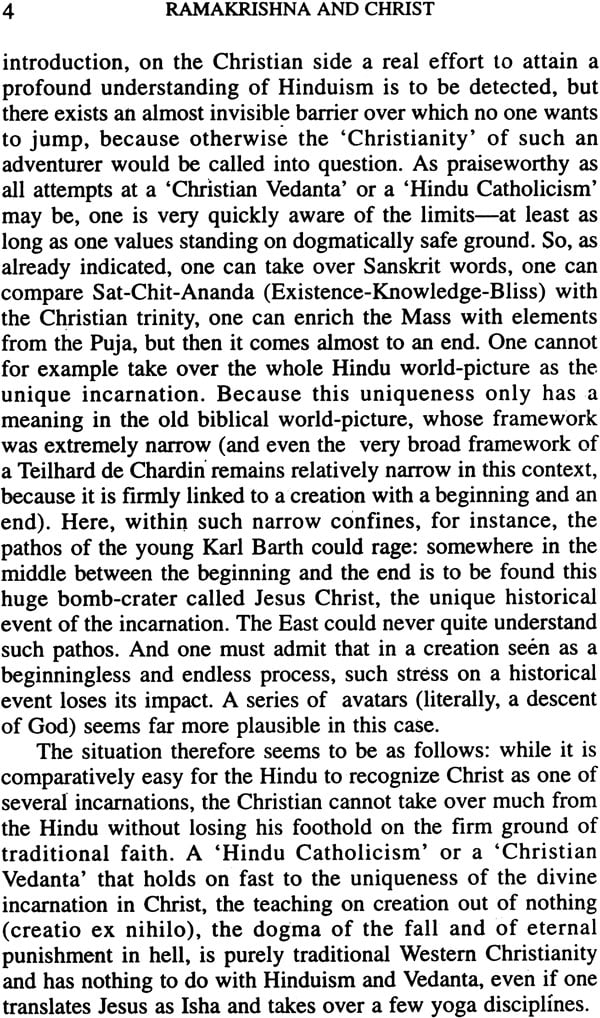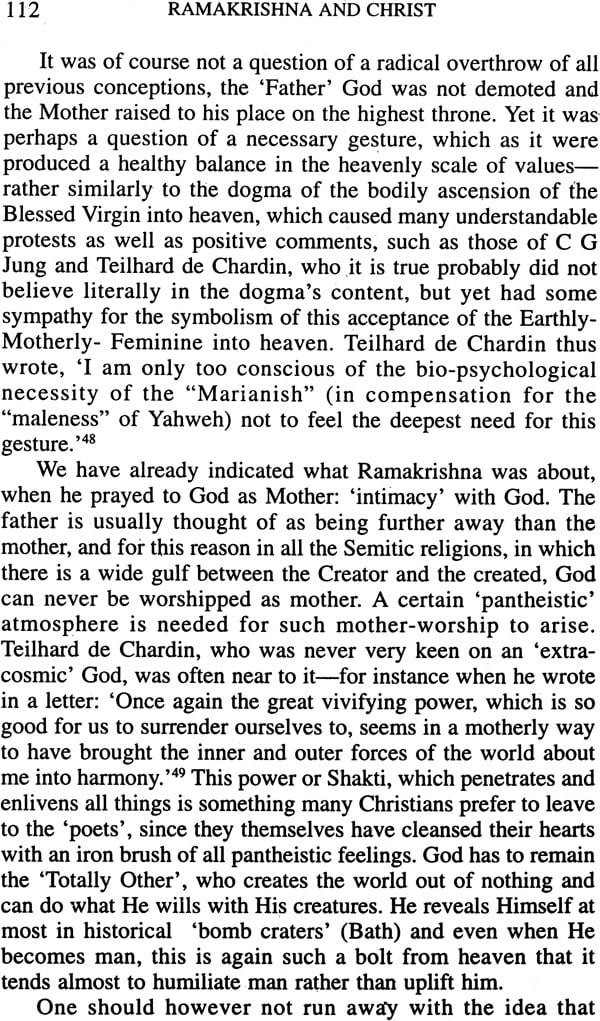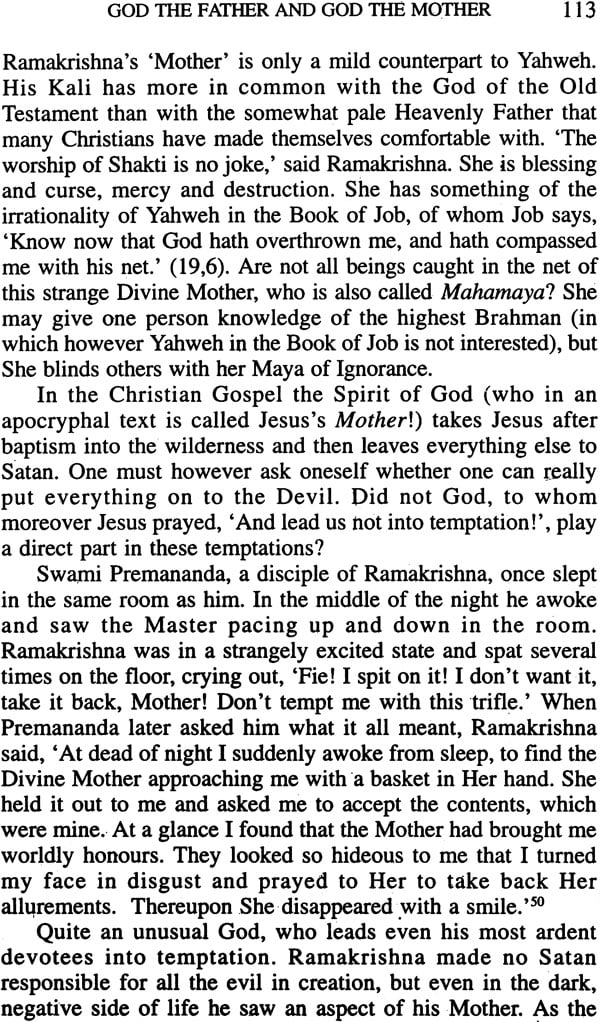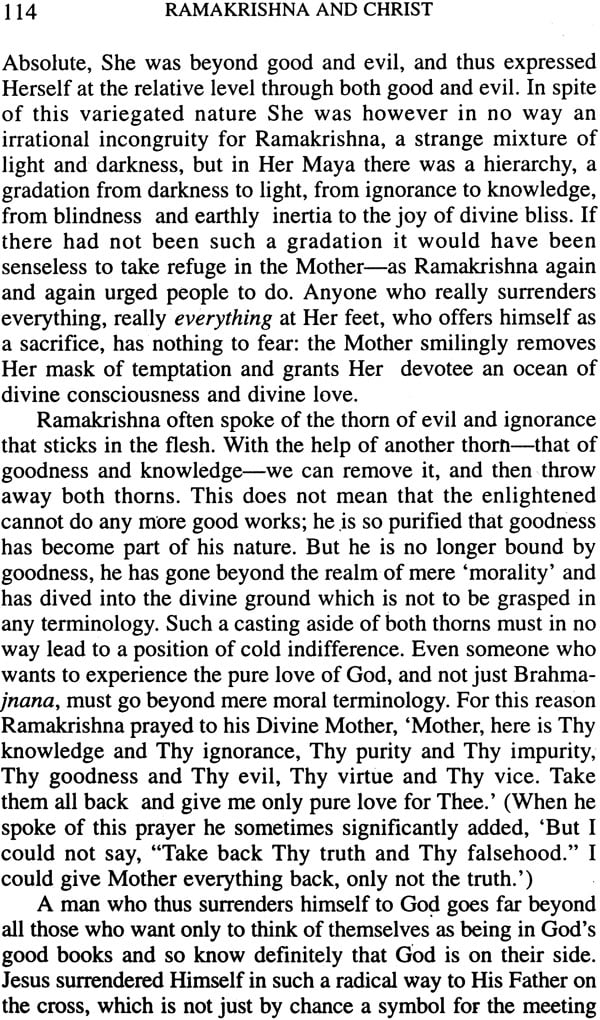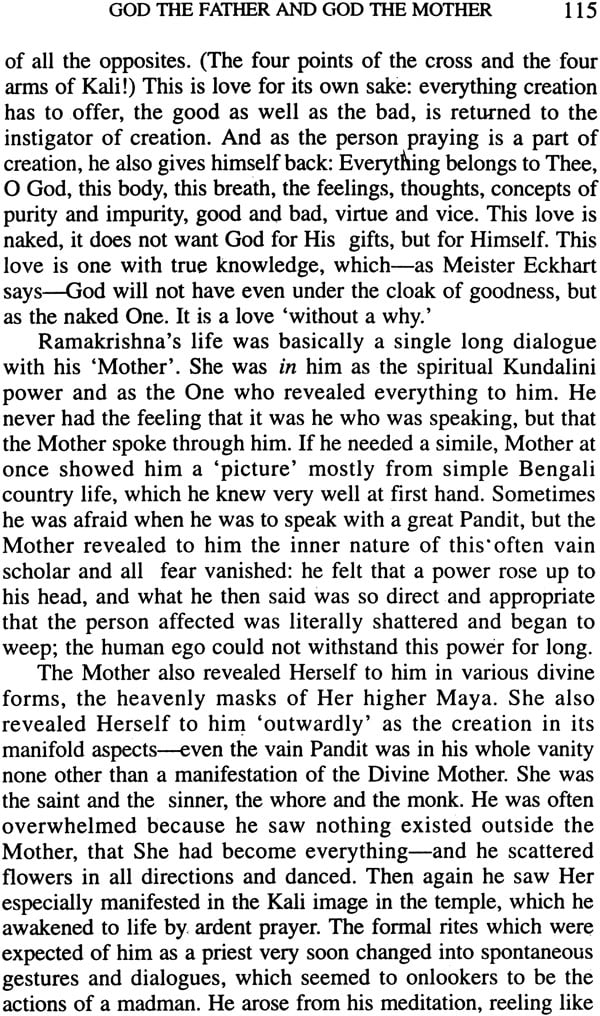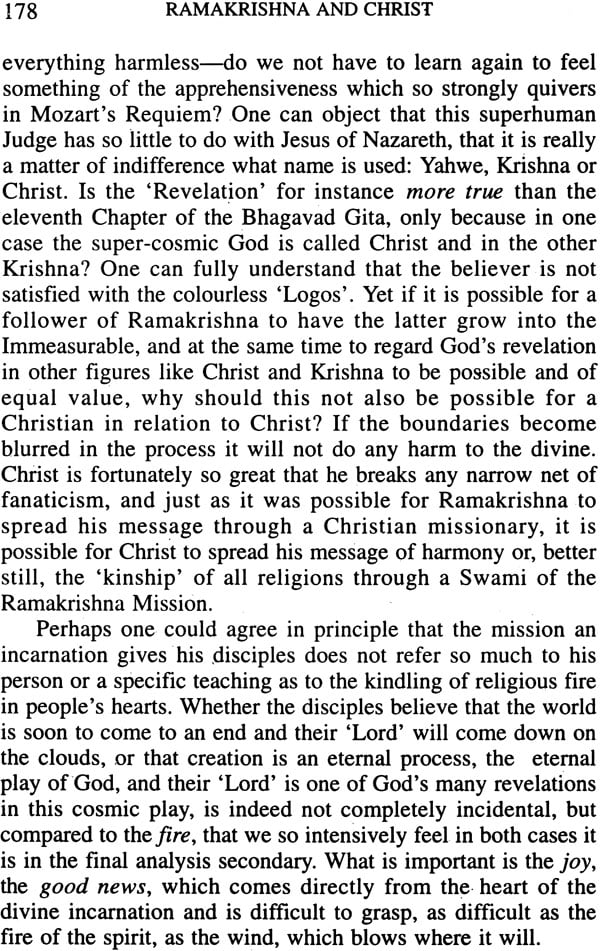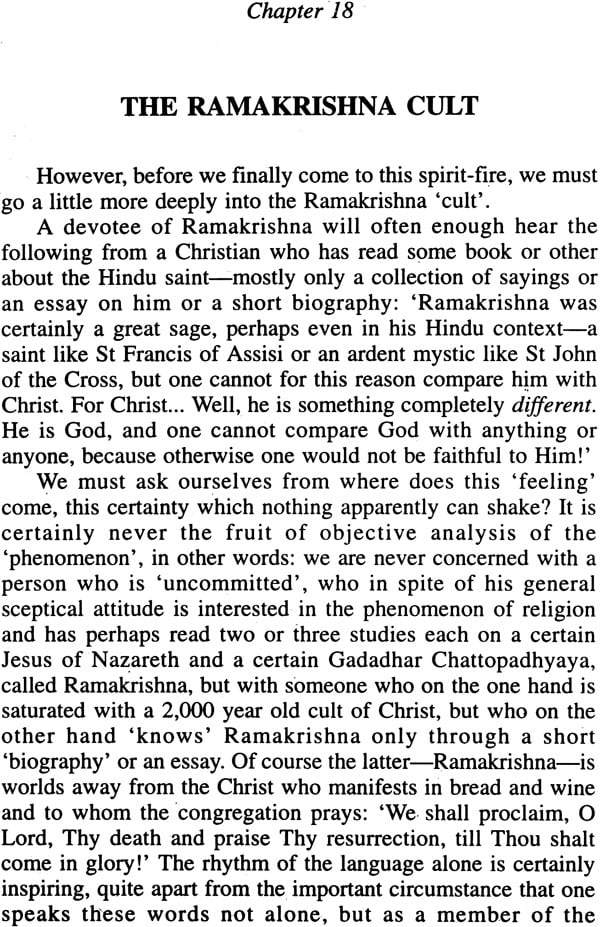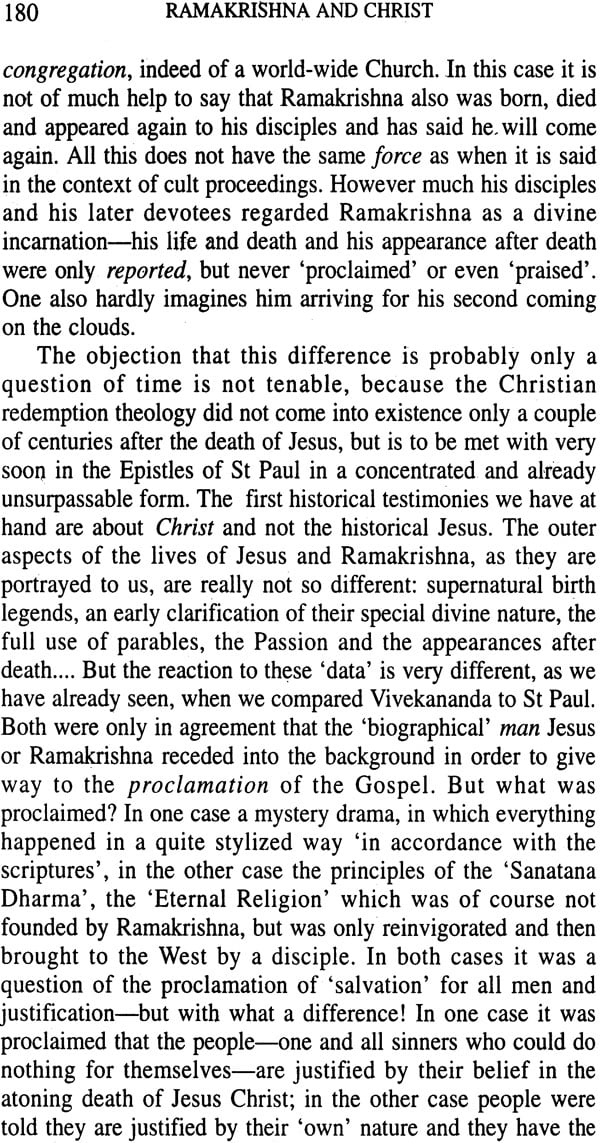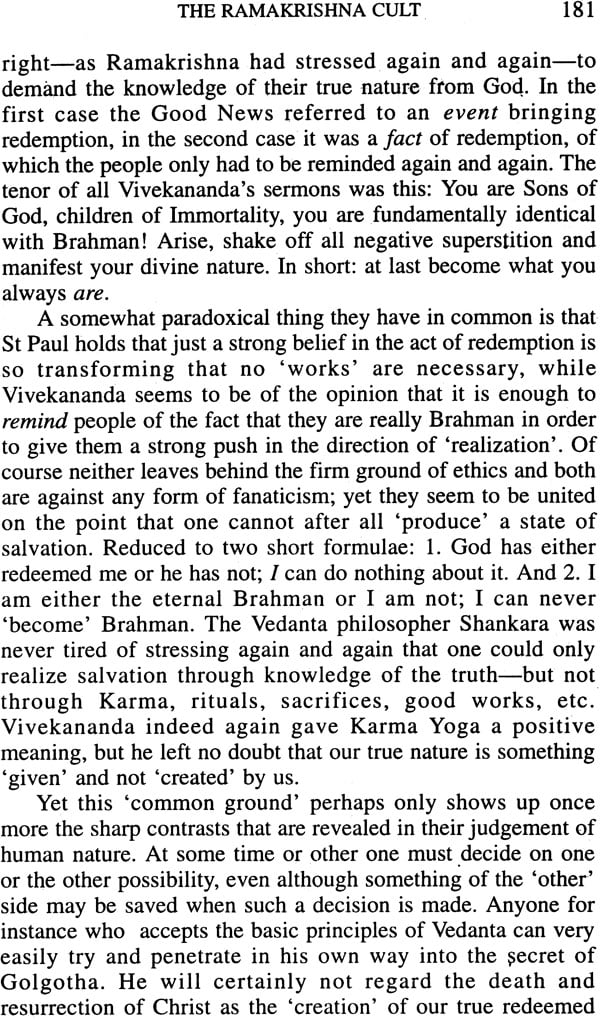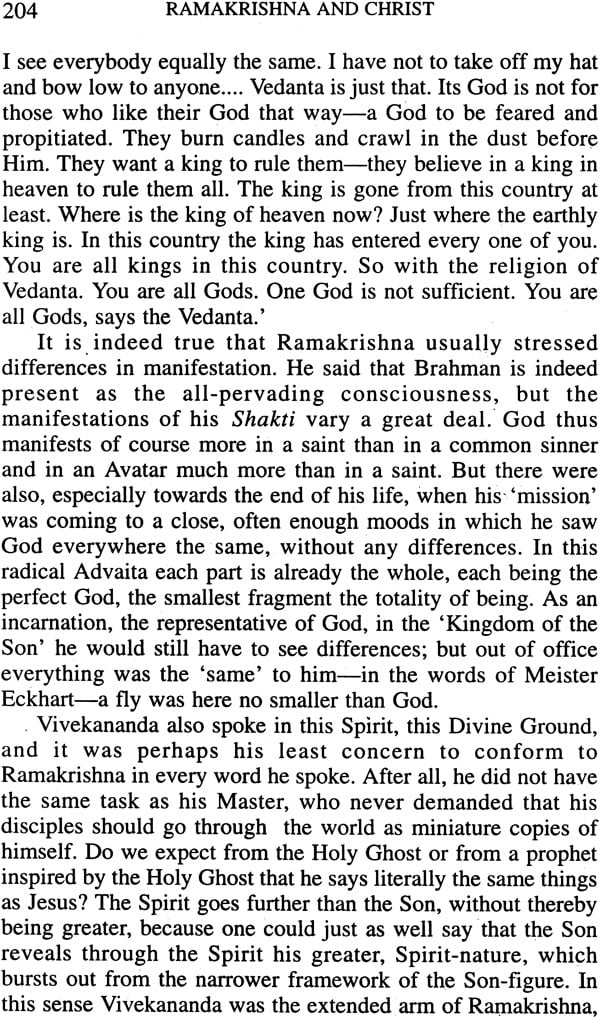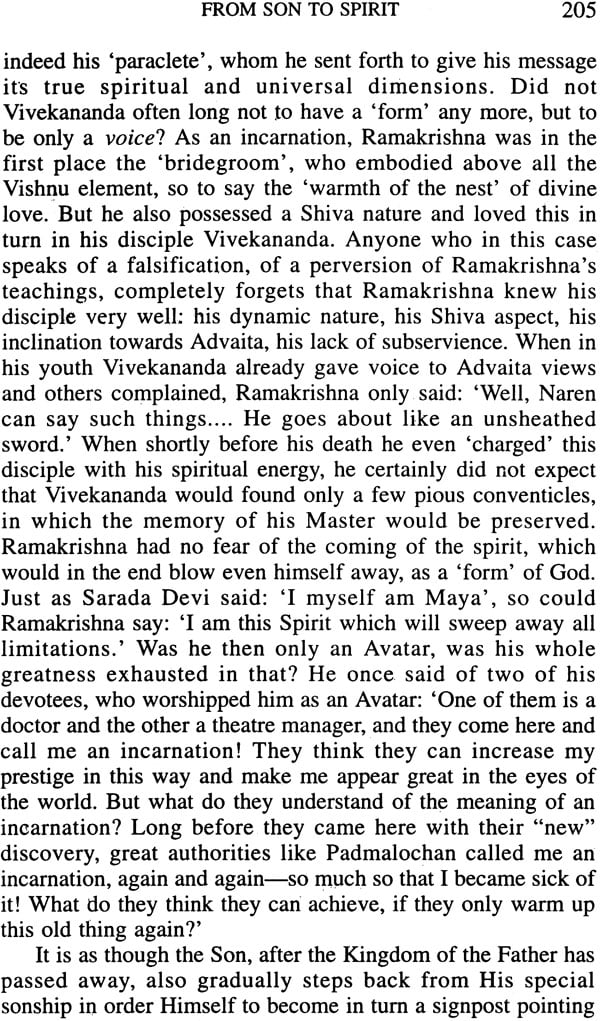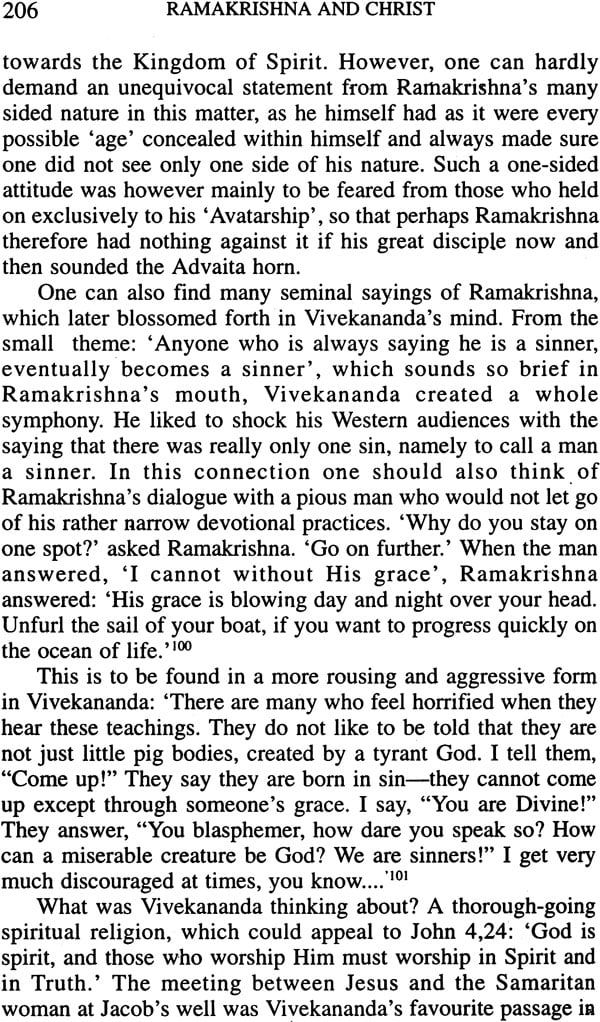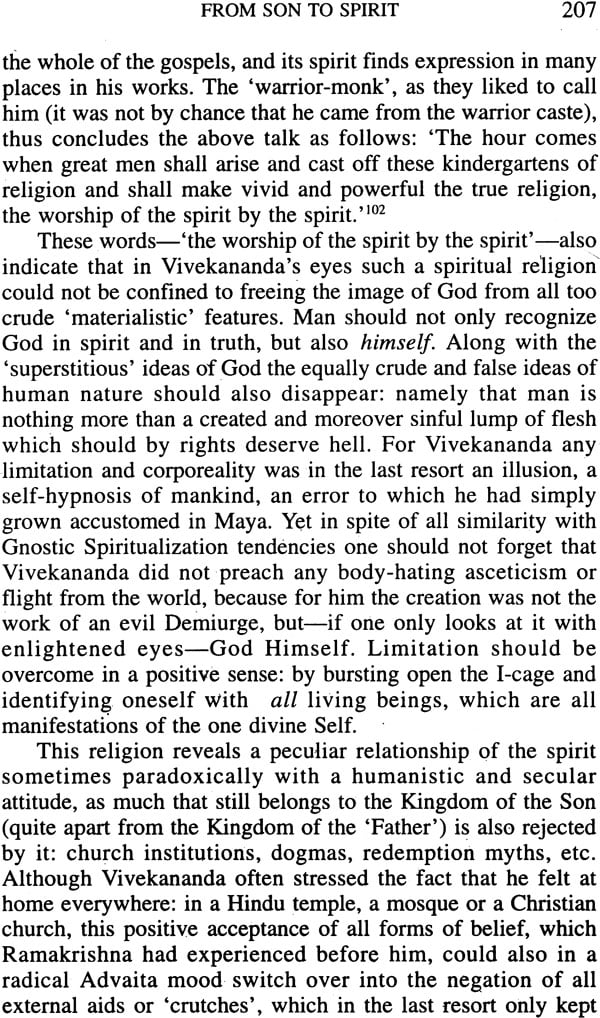
Ramakrishna and Christ or The Paradox of the Incarnation
Book Specification
| Item Code: | NAH564 |
| Author: | Hans Torwesten |
| Publisher: | Ramakrishna Mission Institute of Culture |
| Language: | English |
| Edition: | 2006 |
| ISBN: | 9788185843971 |
| Pages: | 244 |
| Cover: | Paperback |
| Other Details | 8.5 inch x 5.5 inch |
| Weight | 280 gm |
Book Description
The doctrine of the incarnation, of the divine word becoming flesh, is the real core of Christian teaching. If it was abandoned, Christian would hardly be distinguishable from the other ‘Semitic’ religion, from Judaism and Islam, and there would also be the danger humanism.
It has however been clear for some time now that the Christian teaching on the incarnation is not so completely unique as it had long been thought to be. Unique is only the teaching of the only begotten Son of God, of the uniqueness of the incarnation of God in Jesus Christ. The threat to Christianity from this direction is not from the strongly monotheistic religions like Islam and Judaism which deny the possibility of a divine incarnation or from the modern ‘scientific’ attitude, but from an almost too willing acceptance of the incarnation, this time from Hinduism. What is willingly accepted is thought to be ‘natural’ and natural things are seldom unique—they repeat themselves, just as everything in nature dose. For this reason the Christian missionaries did not meet with derision from most Hindus when they told them the story of the head: ‘Yes, we know about that, we have it too.’ If the missionaries then took offence and declared that they did not want their Christ to be put on an equal footing with unhistorical avatars and elephant gods, they were often regarded as fanatics and Western imperialists. It seems that two worlds collided which in spite of the many things they held in common came from quite different origins. This book deals with both of them: with the things that unite them and with the things that divine them.
Ramakrishna and Christ or the Paradox of the Incarnation’ is a comparative study and analyses of the incarnation as embodied in Jesus Christ and Ramakrishna. The author, Hans Torwesten, who has had practical experience of religious life in India and Europe, is in an excellent position to compare both these phenomena.
Ever since Sri Ramakrishna had the unique spiritual experience in which he and Christ embraced each other and Christ merged into him, several studies on the two have been published, including Swami Vivekananda's lecture, 'Christ the Messenger'. Though most of these studies represent the Hindu view of Christ, this has also prompted Christian scholars to study Sri Ramakrishna. The number of serious studies on him, however, is far from adequate.
About six decades ago, Romain Rolland did a study of Sri Ramakrishna as 'the younger brother of our Christ,' which was based on reliable materials collected from different sources. Hans Torwesten's practical and direct encounter with philosophy and religion in both India and Europe, combined with his honest endeavour to unravel the mystery of the 'Incarnation' as revealed in the lives of Christ and Ramakrishna, have in the present work earned him a unique place, not achieved by earlier scholars. His Ramakrishna and Christ, or the Paradox of the Incarnation, the English translation of his German work, Ramakrishna und Christus oder das Paradox der Inkarnation, lucidly presents the author's perceptive revelation of 'Pleroma,' the absolute fullness of the divine joy in Sri Ramakrishna, and that in this message of joy he is united with Christ in spirit.
We are grateful to the author and to the Ramakrishna Vedanta Centre, Bourne End, Buckinghamshire, U. K., for their permission to bring out the Indian edition of this book. We know that English-knowing Indians will greatly enjoy reading this work.
The doctrine of the incarnation, of the divine word becoming flesh, is the real core of Christian teaching. If it was abandoned, Christianity would hardly be distinguishable from the other 'Semitic' religions, from Judaism and Islam, and there would also be the danger that it would only be regarded as one of the many forms of present-day humanism.
It has however been clear for some time now that the Christian teaching on the incarnation is not so completely unique as it had long been thought to be. Unique is only the teaching of the only begotten Son of God, of the uniqueness of the incarnation of God in Jesus Christ. The threat to Christianity from this direction is not from the strongly• monotheistic religions like Islam and Judaism which deny the possibility of a divine incarnation or from the modern 'scientific' attitude, but from an almost too willing acceptance of the incarnation, this time from Hinduism. What is willingly accepted is thought to be 'natural', and natural things are seldom unique-s- they repeat themselves, just as everything in nature does. For this reason, the Christian missionaries did not meet with derision from most Hindus when they told them the story of the incarnation of God on earth, but were greeted instead with a happy nod of the head: 'Yes, we know about that, we have it too.' If the missionaries then took offence and declared that they did not want their Christ to be put on an equal footing with unhistorical avatars and elephant gods; they were often regarded as fanatics and Western imperialists. It seems that two worlds collided which in spite of the many things they held in common came from quite different origins.
This book deals with both of them: with the things that unite them and with the things that divide them. The latter are still very much in evidence, although on the Christian side one is now at least ready to listen to the 'other'-instead of regarding him only as material for conversion.
Today the majority of Christian missionaries would indeed have just as little doubt as their predecessors of about a hundred years ago of the uniqueness of their Christian revelation and especially of the founder of their religion, but the earlier arrogance and presumption have largely disappeared. Nowadays they study in detail the original texts of the Hindu religion, take over certain outward forms of the ritual, 'baptise' some philosophical terms in Sanskrit and even sometimes dress in the ochre robe of the Hindu monk.
But this book is not about the problems of Christian missionaries in India; the writer is not a missionary, even though once at the age of thirteen or fourteen he dreamed in a Franciscan school of converting all the Indians of Brazil and even the whole of India and Japan to the true faith. He still thinks of himself today as a Christian-although as a Christian who finds himself just as much at home in the Indian spiritual sphere as he does in his inherited Catholic faith. I am well aware that not every Christian will be prepared to cross over the boundary to the other side to the extent that I do in this study. In attempting this it is not a question, as already indicated, of how deep a representative of the Christian faith may penetrate into the heart of Hinduism in order to plant Christ in the inmost recess of that religion. Others have written about this aspect, Bede Griffiths for instance, or Klaus Klostermaier. Although these pioneers reached a genuine understanding they never seriously succumbed to the temptation to jump over the fence and become a Hindu-not in the external sense, of course, because for a Westerner it is hardly possible to fit into the Hindu social structure; but nevertheless to such an extent that one suddenly sees Christianity from the other side, and that means above all that it is made relative.
Something like this happened to me, even if in fact it was very much more complicated than can be indicated within the framework of a book such as this. Complicated mainly because the tables cannot just be turned like that: I am not in any way invading the Christian camp now as a 'Hindu missionary'. I still one who would gladly tell his fellow-believers something of the treasures he found on the 'other' side. I doubt whether I would have found these treasures if I had only searched about a little in the other religion as a 100 per cent stable Christian. I had to a certain extent to identify myself with a religious group that is 'completely immersed in the religion and philosophy of India. For this purpose it was not a question-to my taste-of any group representing an already rigid Hinduism, nor one of those new groups whose Indian spirituality seemed all too diluted for me. I found the middle path between these extremes in the Ramakrishna movement, to which I feel bound even today, although I no longer live in one of its ashrams.
For most Christians, Ramakrishna-if they know of him at all-is fortunately not a red rag to a bull. Christians have written almost always with approval about him and about the Ramakrishna Mission founded by his disciple Vivekananda. When his picture was placed on the altar one evening in an English Dominican friary during a retreat in which Hindus as well as Catholics and Protestants participated and an Indian Swami celebrated a short Arati service before it, none of the Christians stood up to tear down the picture. It even happens that a Benedictine monk hangs up a large picture of Ramakrishna in his study and this not in India, as a gesture of tolerance, but in Germany, in the very depths of the Western World. One at once asks oneself what such a monk can see in Ramakrishna-a sage, a Hindu Saint Francis or even a revelation of God-only of course on a more modest scale than the revelation of God in Christ.
I will not make any more conjectures. My task in this book is to work out what I see in Ramakrishna. Such a task scarcely needs any justification, because although the phenomenon of Ramakrishna has always been approached with a certain warmth of feeling and sympathy, the number of serious studies on him is far from adequate. It almost seems as though a serious encounter with him has been avoided, because in some way he is too close to us Christians. Either he is put out of harm's way by regarding him as a simple village saint or else he is pigeon-holed as an Indian 'sage'.
If in this book I am not concerned with such simple. definitions, it is not because I want to play him off as a person against Christ, but because the subject of the 'incarnation' is a continual preoccupation with me, because I see in Christ and incarnation of God and because I believe that a stud y of Ramakrishna throws a little more light on this. mystery and thereby on Christ as well. I must of necessity write more about Ramakrishna, because he is the more unknown, because he still needs to be introduced to many, which is not the case with Christ. The phenomenon of Ramakrishna-after a few general chapters about the difficulties of the dialogue, the problems of the teaching of the incarnation and aspects of Indian philosophy-will be portrayed in its full richness, with its special aspects. But always with one eye on the subject of the ‘incarnation’ and thus also on Christ.
| Publisher's Note | v | |
| Introduction | IX | |
| 1 | Difficulties in the Dialogue | 1 |
| 2 | The Paradox of the Incarnation | 7 |
| 3 | Advaita Vedanta and the Avatar Doctrine | 13 |
| 4 | Maya | 22 |
| 5 | God's Fool of Dakshineswar | 26 |
| 6 | The 'Indwelling' of God | 34 |
| 7 | The Nature of the Avatar | 46 |
| 8 | Ramakrishna's 'Predecessors' | 56 |
| 9 | The Encounter with Christ | 75 |
| 10 | Transfigurations and Miracles | 83 |
| 11 | The Kingdom of Heaven is at Hand | 94 |
| 12 | God the Father and God the Mother | 107 |
| 13 | Sarad aDevi | 119 |
| 14 | The Inner Circle | 130 |
| 15 | Golgotha | 142 |
| 16 | The Resurrection | 154 |
| 17 | Go Forth into the World | 164 |
| 18 | The Ramakrishna Cult | 179 |
| 19 | From Son to Spirit | 198 |
| Conclusion | 212 | |
| Notes | 219 | |
| Translation of Sanskrit Terms | 223 |
